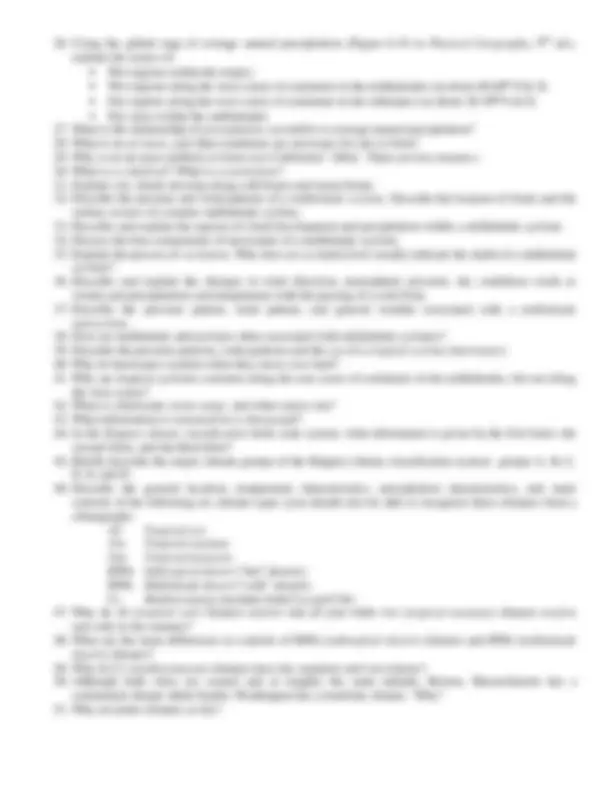
City College of San Francisco Spring 2009
GEOG 1—Physical Geography
Darrel Hess
Second Midterm Examination Study Questions
The questions below will help you focus on the most important concepts presented in class as you prepare for
the second midterm exam. These questions don’t necessarily represent everything you may be tested on (nor
will you necessarily be tested on all of the material noted below), but these questions are a good starting point
as you study for the exam.
1. Describe the general location and characteristics of the jet streams of the westerlies.
2. What are Rossby waves?
3. Briefly describe the location and general characteristics of the high-latitude components of the general
circulation patterns: the polar front, the polar easterlies, and the polar highs.
4. Describe and explain the seasonal shifts of the general circulation patterns. Especially note the
significance of seasonal shifts of the intertropical convergence zone (ITCZ) and the subtropical highs.
5. Describe and explain the South Asian monsoon.
6. Explain the origin of land-sea breezes.
7. Describe the conditions associated with relatively high rates of evaporation, and the conditions
associated with relatively low rates of evaporation.
8. What is absolute humidity?
9. What is relative humidity?
10. What determines the water vapor “capacity” of air?
11. What happens to relatively humidity when the temperature decreases? Why?
12. What happens to relatively humidity when the temperature increases? Why?
13. What is meant by the dew point temperature of a parcel of air?
14. Which cooling process in the atmosphere is responsible for the formation of most clouds—and nearly all
clouds that produce precipitation? (Hint: It was one of the ten basic heating and cooling processes
discussed in Chapter 4.)
15. What happens to the relative humidity of an unsaturated parcel of air as it rises? Why?
16. What is the relationship of the dew point temperature of a parcel of air to its lifting condensation level?
17. What is latent heat?
18. Why is evaporation a “cooling” process and condensation a “warming” process?
19. Why does a parcel of unsaturated air cool more when it rises 1000 meters than a parcel of saturated air
(in which condensation is taking place) when it rises 1000 meters? In other words, explain why there is
a dry adiabatic rate and a saturated adiabatic rate.
20. Why can’t descending air form clouds?
21. What is the difference between stable air and unstable air? What makes air unstable?
22. Describe the three main forms (shapes) of clouds.
23. Are stratus clouds associated with stable or unstable air? Are cumulus clouds associated with stable or
unstable air?
24. Describe the four main lifting mechanisms of air.
25. What is a rain shadow and what causes one to form? In your answer, explain the role of adiabatic
temperature changes, as well as changes in relative humidity and the actual water vapor content of the
air in the formation of rain shadows.










